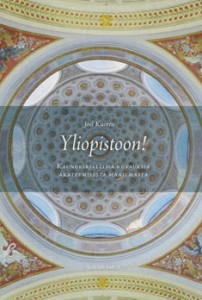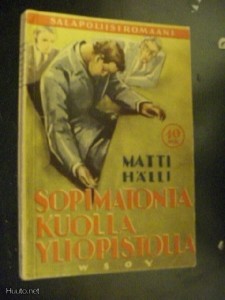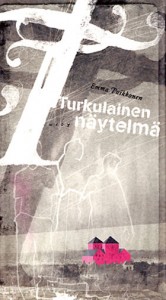In the summer of 2005, I happened to read a Finnish detective novel by Matti Hälli, titled Sopimatonta kuolla yliopistolla (1943) [It Is Unbecoming to Die at the University]. The text intrigued me so much that I wrote a short piece on it to the University Employee Unions’ magazine, Acatiimi. What was then just an occasional piece has become a long series of texts – still continuing. After 50 articles, it was time to collect the pieces together – with some new material. The result is now a book called Yliopistoon! Kaunokirjallisia kuvauksia akateemisesta maailmasta (Gaudeamus 2013) [To the University! Fictional Accounts of the Academia]. Basically, I deal with novels and poems from the 14th century until the present day in which university, academic environment, and/or student life is in some way represented, lived out.
What I find most interesting in my explorations into the stories about and around Finnish universities (and a couple of detours into Nordic academic life) is that university life has not changed that much during the centuries. Sure, the physical environment has changed tremendously but the basic need to gain knowledge, the epistemological drive, as well as the requirement to educate students for the purposes of public life, has remained so recognizable throughout the ages.
In literary representations of university life, there is no end to murders, love stories, tragedies, parties, money troubles – or even studies. As an example, we can take for example the young writer and dramatist Emma Puikkonen who in her debut novel Turkulainen näytelmä (2001) [A Drama in Turku] combines contemporary student life with a story set in the Turku of 1590s. The protagonist, Nadia, takes part in a play by the Turku Student Theatre: Josef Julius Wecksell’s Daniel Hjort (1862). Nadia calls it the first Finnish tragedy, a Turku version of Hamlet. It is a story of Daniel Hjort and his beloved Sigrid Stålarmintytär, played by Nadia.
Nadia’s story is about identity crisis, about a Hamlet-type of person (not Ophelia) who is uncertain. She dreams of meeting one of the innumerable young, talented, dark-eyed, and anxious poetry boys Turku teems with. Her aimlessness is amply illustrated in her ride on the föri ferry as she goes back and forth without alighting. She watches the Art Academy students on the other side of the Aura river heading for the old rope factory, and the students of the (then three) universities on the other side cycling up “to the lecture halls and paper smell, the recluse research chambers which breed love for Sartre, bylaws or quantum mechanics” (p. 106).
Nadia’s and Sigrid’s lives get intertwined in the course of the novel in an interesting way. Nadia is not content with the director’s (or the script’s) version of Sigrid as the fragile angel on a pedestal. Nadia and Sigrid know that in the patriarchal world, the young woman always dies, all the more certain the more there is concealed passion. They want to be written differently, to write their own lives.
See also the blog, Café Pour Les Idiots, for a feature on the book in Finnish.
Text and Images: Joel Kuortti


